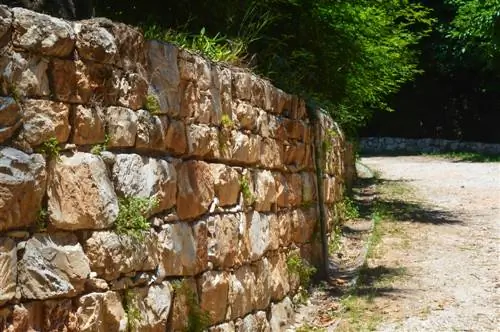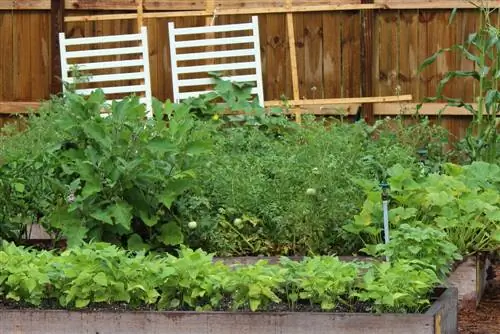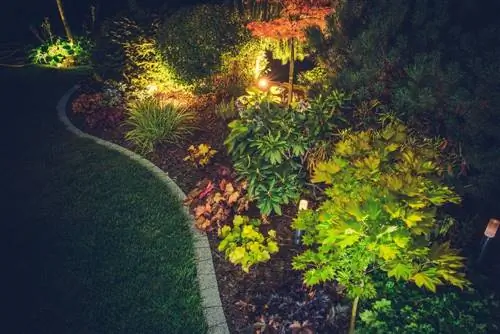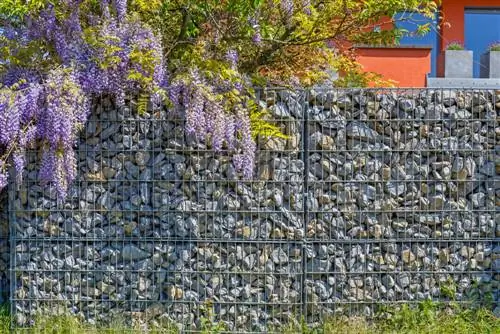- Author admin [email protected].
- Public 2023-12-16 16:46.
- Last modified 2025-01-23 11:21.
A stone privacy screen can relatively effectively shield not only visual but also acoustic disturbances in the garden. However, in addition to safety and appearance, garden owners should also consider other factors when planning a stone privacy wall.
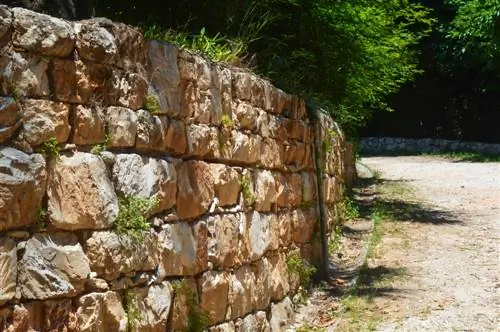
What should you pay attention to when choosing a stone privacy screen in the garden?
A stone privacy screen in the garden offers both visual and acoustic screening. Before construction, legal regulations, stability of the subsoil, choice of materials and ecological added value should be taken into account. Variants include natural stone walls, brick walls or gabions.
Preliminary considerations before building stone privacy walls
Before you can start building a stone privacy wall in your own garden, the most important questions about the following factors should first be clarified:
- legal regulations/required permits
- Stability of the subsoil
- Material and surface design
- Ecological or practical added value of the built stone wall
In many cases, official approval from the responsible building authority may be required to erect a stone privacy wall. The prescribed minimum distances from the property line also come into play. In addition, in contrast to planting a privacy hedge, walls made of natural stone or stone baskets require careful examination of the respective substrate. After all, ordinary soil can sink, be washed away or simply give way under the often underestimated weight of a stone wall. In such a case, life-threatening accidents can sometimes occur if a stone wall collapses. While brick walls and gabions hardly offer any ecological niches, a natural stone wall can provide a habitat for rare plants and animals in its cracks.
Safety through a suitable base
If approval has been given for the construction of the planned stone wall, the preparatory work can begin. As a rule, a trench is dug along the planned route of the stone wall, which is first filled with some coarse gravel and then provided with a stable foundation made of base stones or concrete. Since this creates an obstacle in the garden in the long term, passages for cables to be laid or water draining underground should be integrated in time on slopes in the form of pipes or empty shafts. As soon as this foundation has hardened and is load-bearing, depending on the material, construction of the actual privacy wall can begin.
Building a privacy screen from demolition material
When old houses are demolished, bricks and natural stones are often uncovered that are far too good to be filled with rubble. When building a stone wall in the garden, it is not necessarily a problem if there are still mortar residues on the individual stones from previous use. Rather, a stone wall made from recycled stones offers a type of patina that immediately allows the newly created masonry to integrate organically into the landscape design. If a more ruin-like look is chosen instead of a strictly geometric design, the result is a special charm with a romantic factor.
Gabions as a contemporary privacy screen
It is not uncommon for landscape planners and gardeners to have different opinions about gabions: These stone baskets offer some advantages in terms of the approval process, as they usually do not have a fixed anchoring to the ground and (at least theoretically) they can be removed quickly at any time can be transported away. However, the rather rugged look of quarry stones and galvanized steel rods cannot necessarily be combined with every type of architecture and landscape design. However, it is certainly possible, for example, to green a wall made of gabions by growing annual or perennial climbing plants.
Tip
The higher a stone wall is built in the garden, the higher the requirements for stability and tipping resistance are. As a compromise between privacy height and reasonable effort, it is advisable to build a raised bed made of stones and then plant it with reasonably tall vegetables or flowers.

